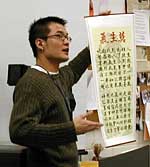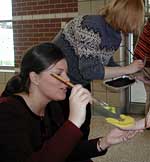Those Who Can, Teach
By Jeff Horwich
February 20, 2001
More than half of Minnesota school superintendents say they are having problems finding enough teachers. Consider that Baby Boomers, the biggest group of teachers, are just a few years from retirement, and the current teacher shortage looks like a looming crisis to some.
St. Cloud State University already produces more teachers than any school in the state, and a new accelerated masters degree program is reaching out to unconventional candidates.
SHANE SIMON, 29, JOINED 25 OTHERS of all ages and careers this week in St. Cloud to consider a mid-life switch to teaching. The occasion was an information session for the Interdisciplinary Teacher Preparation Program at St. Cloud State. After college, Simon found his way to a job as a jailer. Now he wants to teach elementary school.
"I see kids coming into the jail coming into the jail every day, and hopefully I can just get to them a little earlier," says Simon.
A typical mid-career professional with no teaching background might expect two years of additional undergraduate course work and student teaching to earn a teaching license. The ITP program aims to do it in 15 months, and throw in a masters degree. The first class of 18 will finish in July.
Seak-kee Chew leads his social studies class at St. Cloud's Apollo High School through a discussion of a recent court decision on Napster, the Web site that allowed downloading of copyrighted music.
To turn out good teachers quickly, students are asked to dedicate themselves completely to the ITP program. But for most of these would-be teachers, the initial decision to enroll was half the journey. Chew, born in Malaysia, came to St. Cloud State for his MBA. After a few months with an insurance company, he knew he had made the wrong choice.
"I was always having to fake myself. In the business world, it's all about profit. No one really cares about who you are and what you're feeling," says Chew.
Chew has been in this same classroom four days a week since September. He'll be here in June. That's compared to four months of student teaching for a typical teaching license. Every afternoon he's in class at the university, and he's doing his own homework in the evenings.
Though Chew lives in town, some of his classmates commute an hour or more every day.
"It's as if really we had no life any more. I've thought about it a few times, am I coming into the right field and do I really want to jump through all these hoops and all this stress? But I think it's still worth it, in the end," says Chew.
Chew's fellow converts include a naturalist, a public relations specialist, a lawyer, and a housewife and mother of six. The program is rigidly structured, and admission is competitive. Directors hope this means they can turn out teachers to meet some specific needs. That means giving all participants a strong background in special education and the ability to work with a diverse student population. It means focusing on those who want to teach science and math. And it means devoting more spaces to those who are willing to teach teenagers. Two-thirds of the seats in the program are dedicated to high school teachers.
Meg Schuler had her worries about returning to high school. The former newspaper editor returned to student teach creative writing under the same teacher and in the same room she had as a student here at Apollo almost 20 years ago.
"I came in to teach poetry class the first day, and there was this kid with a big black trench-coat and crazy spiked hair, and I thought, 'What am I getting into here?' But then he pulled me aside and he asked, 'Is it OK if I take some of my old poems and fix them up a bit?'" Schuler recalls.
A similar program aimed at mid-career professionals exists at St. Mary's University, and Winona State University will start one in the fall. The state's teachers' union is comfortable with the level of training in the ITP program at St. Cloud. But Co-President Judy Schaubach says there's no quick fix to put more teachers in the classroom, and faster, more intense programs may not work on a large scale. One-third of teachers quit in their first five years, and longer training has a big effect on this turnover rate.
"The concern is that we don't think that just everyone can complete this in such a very short period of time. The turnover rate doubles when they're not fully prepared," Schaubach says.
The ITP program has its critics within the College of Education, who say privately that it may be expanding and changing too quickly. Some faculty worry about its potential to divert money from standard classes. Like higher ed programs of all stripes around the state, its fate may ultimately be closely tied to the MnSCU budget.
With the first experimental year out of the way, and the strong support of the college dean, the pilot program seems to have the green light for now. The next crop of intensive teachers-in-training will increase from 18 to 60.
Jeff Horwich covers central Minnesota for Minnesota Public Radio's Mainstreet unit. Reach him via e-mail at jhorwich@mpr.org.
By Jeff Horwich
February 20, 2001
|
|
RealAudio |
More than half of Minnesota school superintendents say they are having problems finding enough teachers. Consider that Baby Boomers, the biggest group of teachers, are just a few years from retirement, and the current teacher shortage looks like a looming crisis to some.
St. Cloud State University already produces more teachers than any school in the state, and a new accelerated masters degree program is reaching out to unconventional candidates.
| |
|
|
|
||
"I see kids coming into the jail coming into the jail every day, and hopefully I can just get to them a little earlier," says Simon.
A typical mid-career professional with no teaching background might expect two years of additional undergraduate course work and student teaching to earn a teaching license. The ITP program aims to do it in 15 months, and throw in a masters degree. The first class of 18 will finish in July.
Seak-kee Chew leads his social studies class at St. Cloud's Apollo High School through a discussion of a recent court decision on Napster, the Web site that allowed downloading of copyrighted music.
To turn out good teachers quickly, students are asked to dedicate themselves completely to the ITP program. But for most of these would-be teachers, the initial decision to enroll was half the journey. Chew, born in Malaysia, came to St. Cloud State for his MBA. After a few months with an insurance company, he knew he had made the wrong choice.
"I was always having to fake myself. In the business world, it's all about profit. No one really cares about who you are and what you're feeling," says Chew.
Chew has been in this same classroom four days a week since September. He'll be here in June. That's compared to four months of student teaching for a typical teaching license. Every afternoon he's in class at the university, and he's doing his own homework in the evenings.
Though Chew lives in town, some of his classmates commute an hour or more every day.
"It's as if really we had no life any more. I've thought about it a few times, am I coming into the right field and do I really want to jump through all these hoops and all this stress? But I think it's still worth it, in the end," says Chew.
Chew's fellow converts include a naturalist, a public relations specialist, a lawyer, and a housewife and mother of six. The program is rigidly structured, and admission is competitive. Directors hope this means they can turn out teachers to meet some specific needs. That means giving all participants a strong background in special education and the ability to work with a diverse student population. It means focusing on those who want to teach science and math. And it means devoting more spaces to those who are willing to teach teenagers. Two-thirds of the seats in the program are dedicated to high school teachers.
| |
|
|
|
||
"I came in to teach poetry class the first day, and there was this kid with a big black trench-coat and crazy spiked hair, and I thought, 'What am I getting into here?' But then he pulled me aside and he asked, 'Is it OK if I take some of my old poems and fix them up a bit?'" Schuler recalls.
A similar program aimed at mid-career professionals exists at St. Mary's University, and Winona State University will start one in the fall. The state's teachers' union is comfortable with the level of training in the ITP program at St. Cloud. But Co-President Judy Schaubach says there's no quick fix to put more teachers in the classroom, and faster, more intense programs may not work on a large scale. One-third of teachers quit in their first five years, and longer training has a big effect on this turnover rate.
"The concern is that we don't think that just everyone can complete this in such a very short period of time. The turnover rate doubles when they're not fully prepared," Schaubach says.
The ITP program has its critics within the College of Education, who say privately that it may be expanding and changing too quickly. Some faculty worry about its potential to divert money from standard classes. Like higher ed programs of all stripes around the state, its fate may ultimately be closely tied to the MnSCU budget.
With the first experimental year out of the way, and the strong support of the college dean, the pilot program seems to have the green light for now. The next crop of intensive teachers-in-training will increase from 18 to 60.
Jeff Horwich covers central Minnesota for Minnesota Public Radio's Mainstreet unit. Reach him via e-mail at jhorwich@mpr.org.


